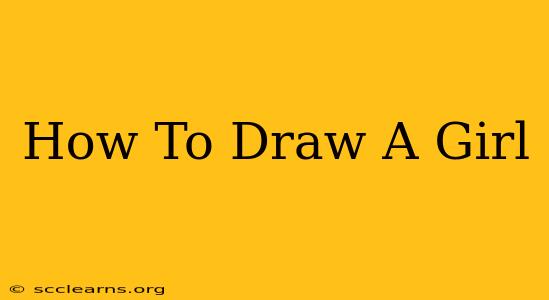Drawing a girl, like drawing anything, takes practice and patience. But with the right approach and some helpful tips, you can create beautiful and expressive portraits. This guide will walk you through the process, perfect for beginners looking to improve their skills.
Understanding the Fundamentals: Proportions and Anatomy
Before diving into the details, it's essential to grasp basic proportions and anatomy. While you don't need to be an anatomy expert, understanding the fundamental structure will make your drawings more realistic and believable.
Proportions: The Key to Believability
- Head to Body Ratio: A common simplification is that the average human body is approximately seven to eight heads tall. This is a guideline; variations exist depending on age and body type.
- Simplified Shapes: Begin by sketching the overall form using simple shapes like ovals and cylinders. This helps establish the basic structure before adding details. Think of the torso as an oval, the head as a circle, and the limbs as elongated cylinders.
- Perspective: Consider perspective; how the figure is positioned in space. Is she facing forward, in profile, or at an angle? This impacts how you draw the body parts.
Basic Anatomy for Girl Drawings
- Facial Features: Practice drawing eyes, noses, mouths, and ears separately before incorporating them into a complete face. Study different facial structures and expressions.
- Hair: Hair can be challenging. Start by drawing the overall shape and mass of the hair, then add individual strands to create texture and volume. Experiment with different hairstyles.
- Body Structure: Observe how the rib cage, shoulders, hips, and limbs connect. Understanding these connections will significantly improve the naturalness of your drawing.
Step-by-Step Guide to Drawing a Girl
Let's create a simple drawing of a girl:
1. The Basic Sketch:
- Start with a light pencil sketch. Begin with a circle for the head and lightly sketch in the basic body shape using simple geometric forms as mentioned above (oval for the torso, cylinders for limbs).
- Indicate the center line of the body to help with symmetry and positioning of body parts.
2. Refining the Features:
- Add details to the face: draw the eyes, nose, mouth, and ears. Be mindful of their placement and proportions.
- Refine the body shape: Add curves and details to the torso, arms, and legs, making them less geometric and more realistic.
- Sketch the hair, paying attention to its overall shape and texture.
3. Clothing and Details:
- Add clothing. Think about the folds and creases in the fabric.
- Add details like shoes, accessories, or any other elements you want to include in your drawing.
4. Shading and Highlights:
- Use shading to create depth and volume in the drawing. Identify light sources and add shadows accordingly.
- Add highlights to give your drawing a sense of shine and realism.
5. Final Touches:
- Erase unnecessary guidelines.
- Refine the lines and details as needed.
- Consider adding a background to give your drawing context.
Tips for Success
- Practice Regularly: The more you practice, the better you will become.
- Use References: Use photographs or real-life models as references to help you understand proportions and details.
- Experiment with Different Styles: Explore different drawing styles to find what you enjoy.
- Don't Be Afraid to Make Mistakes: Mistakes are part of the learning process.
- Have Fun! Enjoy the process of creating art.
Beyond the Basics: Exploring Different Styles
Once you've mastered the fundamentals, explore different styles like anime, manga, realism, or cartooning. Each style has its unique characteristics and techniques, offering plenty of room for creativity and experimentation. Learning to draw a girl is a journey, not a destination. Embrace the process and enjoy the creative expression it allows.

